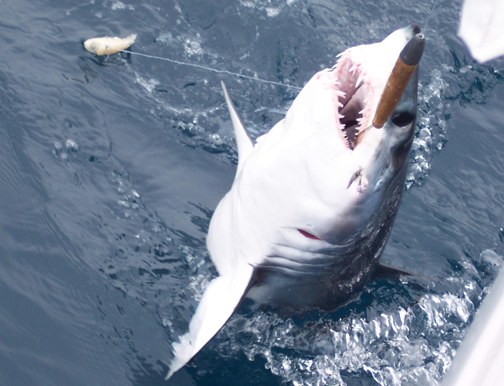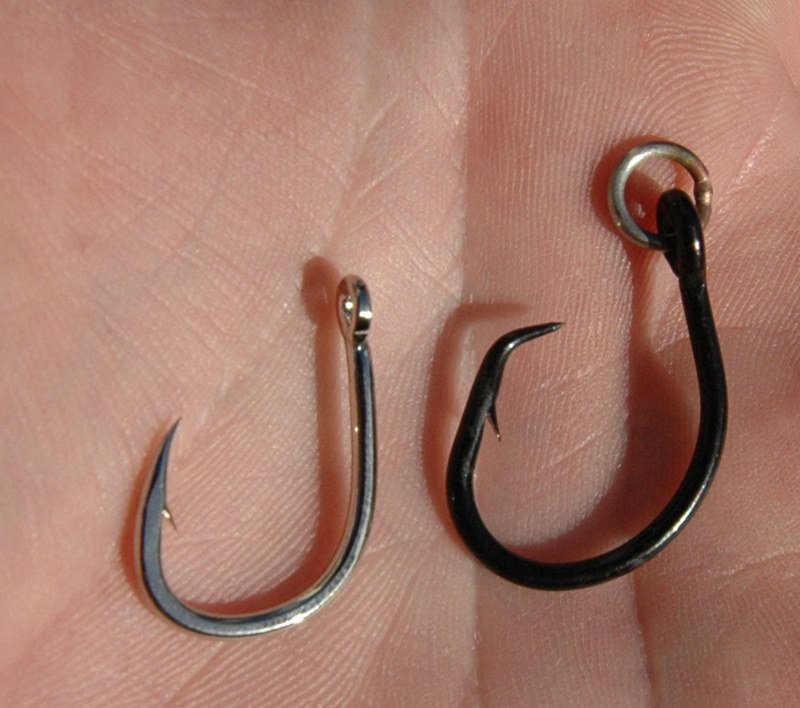
No Serenity Till We Get Rid of This Guy

©2008 Latitude 38 Media, LLC
"You asked for sailors to send in photos of their catches while sailing," write Dennis and Sue Nespor of the Catalina 36 Serenity Now. "Well, we were trolling a cedar plug on the front side of Catalina when we hooked this mako shark. After seeing his choppers, we decided to cut the line and release him."
Rob Grant, our Racing Editor, who lived and worked at Catalina for a number of years, says it’s a very good thing to release makos. "They’re an apex predator, meaning they’re at the top of the food chain and responsible for keeping the populations of their prey in balance. The females give birth to live babies after a gestation period of up to 18 months, then typically take a break long before having another go, so they don’t reproduce quickly. Their acrobatic prowess — they’ve been known to leap more than 20 feet out of the water and ‘tail walk’ for distances of more than 30 yards — and tasty flesh make them popular targets for recreational fisherman hunting ‘trophy’ fish. Female makos grow much larger than males — specimens over 1,000 lbs have been taken in the Southern California bight, an important pupping ground for the sharks — and are typically more targeted as a result, so many mako tournaments have added ‘catch and release’ divisions to help preserve the resource. Mako sharks are extremely dangerous, especially if brought boatside while still ‘green’, and should be handled cautiously. Realistically, a cruiser prepared only for casual fishing shouldn’t try to land one of these majestic animals — any small enough to consider taking deserve a chance to grow bigger and reproduce."

©2008 Latitude 38 Media, LLC
Dennis and Sue made a good choice by letting this guy or girl go. You can help make sure any fish you’ve released has a better chance of survival by making a few simple choices: 1) Use ‘circle’ hooks — these hooks are shaped as their name suggests, which means that it’s more likely to get lodged in the fish’s jaw instead of tearing up its insides like a ‘J’ shaped hook; 2) Don’t use stainless steel hooks — in case you have to leave one in a fish you’ve released, a plated or galvanized mild-steel hook will dissolve faster in the saltwater, allowing the fish to get back to eating sooner; 3) Cut the line as close as possible to the hook if you can’t remove it without injuring yourself or the fish — it’ll be more likely to function like it would without the new facial jewelry!
Warning! Undeliverable Mail
Everyone can relate: One minute you’re surfing your favorite sailing site, the next your screen is black and all your chartering photos from the last three years’ vacations are gone. Poof!
Sadly, something of that nature happened to Latitude‘s email system a couple of weeks ago and it seems to have affected ‘Lectronic Latitude notifications. If you haven’t been receiving your alerts that new ‘Lectronics have been posted, you were one of the many readers whose email was zapped. The good news is that we think we were able to restore most of our list, but if you didn’t receive your notification for this edition, you’ll need to resubscribe. If you did receive a notice, you don’t need to do a thing except read on.
To resubscribe, click here and press send (don’t change the subject line). And if you’re not already subscribed, it’s a great way to be reminded to check out the new ‘Lectronic on your lunch break. (We never share our email list, so don’t worry about unwanted spam.) We apologize for the inconvenience but we don’t want anyone to miss a single edition!
Big Backlog at the Ditch
Many cruisers are heading south toward Panama at this time of year. But when they reach the Canal, they may be in for a rude shock.
According to cruising guide author Pat Rains, there is currently a huge backlog of yachts and ships waiting to transit. Two Canal agents recently told her "yacht transits are presently backed up for about four weeks, even if they were scheduled to transit sooner. They said all the marinas on both ends are packed to the gills with people waiting to get through."

Apparently authorities are only allowing six yachts per day to start transit
(three from the Pacific, three from the Caribbean), and they must anchor
in Gatun Lake overnight before completing the trip the next day, which means additional costs.
"I think at this time of year, normally they’d have 15 to 20 per day going all the
way through. . . The 7% rate increase started March 1, but the back-up problem
started last week when the pilots refused to work overtime, so ships
are even more backlogged than yachts (104 ships are currently waiting to transit).
And, of course, ships are getting priority."
Pat’s sources advised that the best strategy is to get admeasured and pay
your fees, then go cruising nearby for a couple weeks, while keeping in touch with the authorities or your agent — and don’t book any non-refundable flights for guests planning to join you. Sadly, the backlog is expected to get worse.
The Real Story on Rick’s Bar in Zihua

©2008 Latitude 38 Media, LLC
There have been rumors circulating on Mexico’s Coconut Telegraph that Rick Carpenter, the owner of Rick’s Bar in Zihua, who has been a great friend of cruisers and the Zihua SailFest, has been kicked out of Mexico. That’s not true. Here’s the real scoop from a person we consider to be a very reliable source:
"Rick applied for his working visa for the 10th year in a row this year. When the Immigration field inspector routinely visited his bar, he found Rick personally serving drinks and collecting money — a no-no because Rick’s visa is as a restaurant consultant. He’s not allowed to do any hands-on work. So they canceled his application for a visa renewal.
"Regulations required Rick to fly out of the country — he doesn’t even have to leave the San Diego Airport before flying back — before returning on a six-month tourist visa, so he can apply for a new working visa. It’s admittedly an expensive and bureaucratic hassle, but ultimately not a great crisis. The situation is actually more common than one might suspect. Folks tend to forget that Mexico is the home team, and that we gotta play by their game rules."
It’s unclear to us how much politics might have played in the actions of the Immigration folks. Thanks to Rick’s understanding of cruiser needs, he’s had a successful business, and that may have caused jealousy among the local owners of competing businesses.
